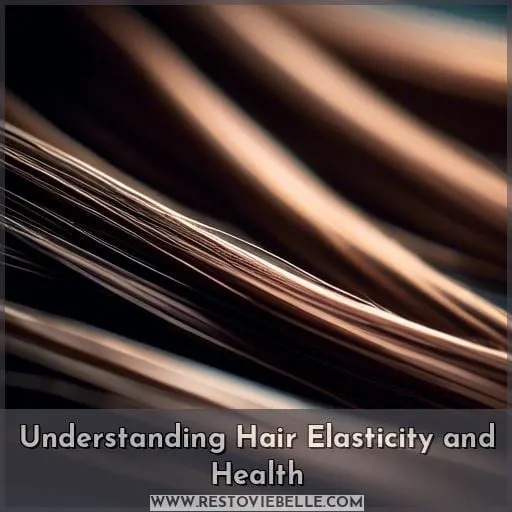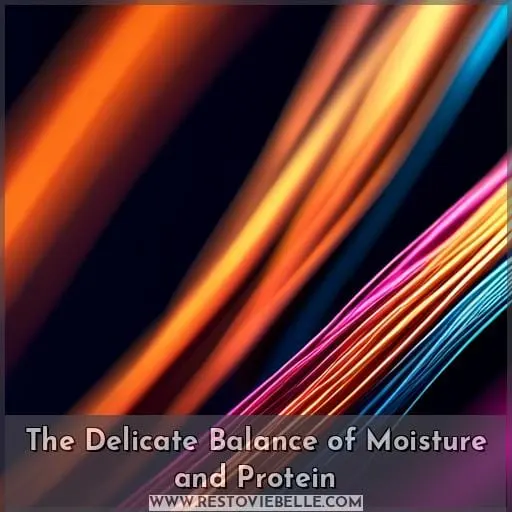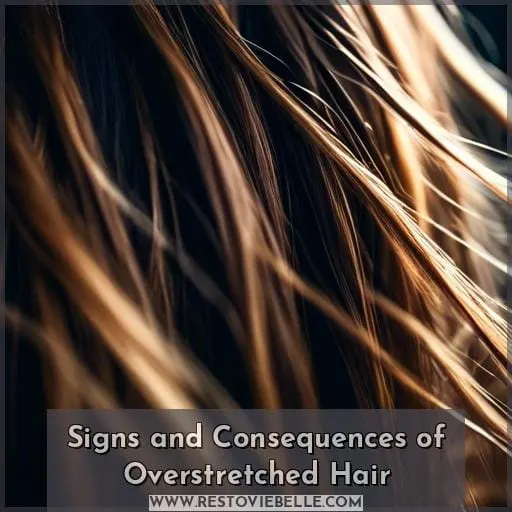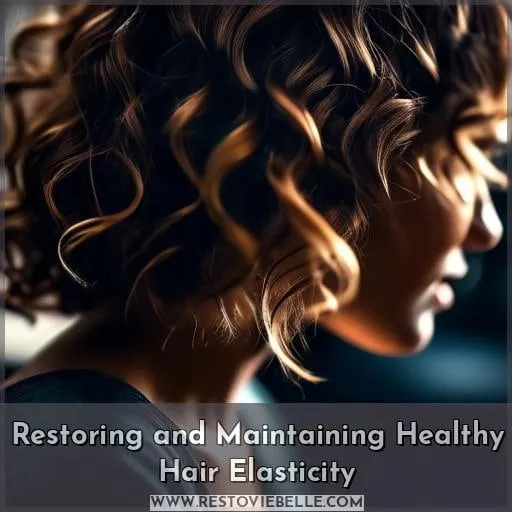This site is supported by our readers. We may earn a commission, at no cost to you, if you purchase through links.
 Your luscious locks, once your crowning glory, now seem to have a life of their own, stretching beyond what feels natural.
Your luscious locks, once your crowning glory, now seem to have a life of their own, stretching beyond what feels natural.
If you’re wondering why your hair is stretchy, it’s a whisper from your tresses, signaling that all is not well within their strands. This unexpected elasticity often points to an imbalance in your hair’s health, where damage from heat, chemicals, or environmental stressors has tipped the scales.
Dive into the heart of hair care as we explore the delicate interplay of moisture and protein that keeps your hair resilient, and learn how to restore the bounce back to your beleaguered locks.
Yes, if your hair is stretchy, it can indicate healthy hair elasticity, meaning your strands are well-moisturized and can retain hydration. However, excessively stretchy hair may signal damage and a need for a protein-moisture balance restoration.
Table Of Contents
- Key Takeaways
- Understanding Hair Elasticity and Health
- The Impact of Chemical Treatments and Heat Styling
- The Delicate Balance of Moisture and Protein
- Signs and Consequences of Overstretched Hair
- Restoring and Maintaining Healthy Hair Elasticity
- Frequently Asked Questions (FAQs)
- Can diet and nutrition affect hair elasticity?
- Are there any genetic factors that influence hair elasticity?
- How does the change of seasons impact hair elasticity?
- Can hormonal imbalances lead to changes in hair elasticity?
- Is it possible to permanently improve hair elasticity, or is it always temporary?
- Conclusion
Key Takeaways
- Hair elasticity is a sign of healthy hair, but excessive elasticity can indicate damage and the need for a protein-moisture balance restoration.
- Chemical treatments and heat styling can damage hair cuticles, leading to increased porosity, susceptibility to breakage, and loss of elasticity.
- A delicate balance of moisture and protein is crucial for hair health, with porosity affecting the hair’s ability to absorb and retain these elements.
- Overstretched hair can lead to increased breakage, tangling, split ends, hair thinning, and loss of resilience.
Understanding Hair Elasticity and Health
When you notice your hair stretching more than usual, it’s like a red flag waving at you, signaling that something’s off in your hair care routine. Imagine your hair as a stretchy band. Ideally, it should bounce back after a gentle tug, showcasing its strength and resilience.
But when it feels more like a worn-out elastic band, barely making its way back, you know it’s time to dive deeper into the world of hair elasticity and health.
Hair elasticity is essentially your hair’s ability to stretch and return to its original length without breaking. This superpower is influenced by a cocktail of factors, including hair porosity, environmental stressors, diet and nutrition, genetics, and, crucially, scalp health.
Think of your hair as a garden; just as plants need the right balance of nutrients, sunlight, and water, your hair requires a harmonious blend of moisture, protein, and care to thrive.
If you’re battling with stretchy hair, it’s a sign that your hair’s elasticity is compromised. This could be due to overexposure to harsh chemicals, heat styling without protection, or simply not giving your hair the TLC it deserves.
But don’t fret! Understanding the root causes, from the role of genetics in determining your hair’s natural resilience to how your diet can impact hair health, is the first step towards reclaiming your hair’s vitality.
The Impact of Chemical Treatments and Heat Styling
Transitioning from understanding the basics of hair elasticity and health, let’s dive into the nitty-gritty of what really puts your locks to the test: chemical treatments and heat styling. You’ve probably heard the saying, beauty is pain, but when it comes to your hair, the real pain is witnessing the aftermath of too much love from your flat iron or the frequent dye jobs.
Chemical treatments and heat styling are like double-edged swords. On one hand, they transform your hair into the silky, vibrant mane of your dreams. On the other, they can lead to a nightmare of cuticle damage, leaving your hair more porous and susceptible to breakage.
Imagine your hair’s cuticle as the protective scales on a fish. Heat and chemicals are like rough waves, battering the scales until they’re lifted and broken. This damage not only makes your hair feel like a stretchy, elastic band but also messes with moisture retention and protein balance, leading to a frizzy, dull appearance.
But fear not! Elasticity restoration isn’t a lost cause. It’s all about striking a delicate balance between moisture and protein. Too much protein, and you’re looking at protein overload, where your hair feels stiff and straw-like.
Not enough, and your hair’s structural integrity waves the white flag, stretching and breaking at the slightest tension. The key is to listen to your hair’s SOS signals and respond with a tailored regimen that nurtures both moisture retention and protein reinforcement, ensuring your locks bounce back to their lively, resilient selves.
The Delicate Balance of Moisture and Protein
After diving into the effects of chemical treatments and heat styling, it’s crucial to understand the delicate balance of moisture and protein in maintaining hair health. Your hair is like a tightrope walker, where moisture and protein are the balancing pole—too much of one side, and it topples over.
- Porosity plays a pivotal role in how your hair absorbs and retains moisture and protein. High porosity hair might soak up moisture like a sponge but struggles to keep it, leading to the need for more protein to strengthen and seal the cuticle.
- Breakage and cuticle damage often signal an imbalance. If your hair snaps easily or feels rough, it might be crying out for moisture or protein.
- Amino acids, the building blocks of protein, help to repair and strengthen hair, filling in the gaps in damaged cuticles and providing the structure your hair desperately needs.
- Hydration is key to soft, supple strands. Without adequate moisture, your hair can become brittle and prone to breakage.
- Achieving the right moisture-protein balance is a personalized journey. Your hair’s unique needs dictate the amount of moisture and protein required to maintain its health and elasticity.
Signs and Consequences of Overstretched Hair
Navigating the tricky waters of hair care, you’ve already learned about the importance of striking a perfect balance between moisture and protein for your locks.
Now, let’s dive into the murky depths of overstretched hair, a telltale sign that your hair’s SOS signals might’ve been ignored for too long. Imagine your hair as a rubber band; when it’s healthy, it can stretch and bounce back with ease.
But when it’s overstretched, it loses its resilience, much like a rubber band left out in the sun too long.
This loss of elasticity can lead to a cascade of hair horrors: increased breakage risk, tangling nightmares that no detangling spray can conquer, split ends that seem to multiply overnight, and hair thinning that makes your ponytail feel like a shadow of its former self.
But fear not, recognizing these signs is the first step to turning the tide and restoring your hair’s health and elasticity. So, let’s untangle this mess together and embark on a journey to reclaim the bounce and vitality of your tresses.
Restoring and Maintaining Healthy Hair Elasticity
After recognizing the signs of overstretched hair, it’s crucial to pivot towards rejuvenation and preservation. Restoring and maintaining healthy hair elasticity isn’t just about quick fixes; it’s a commitment to your hair’s overall well-being.
-
Hydrate and Nourish: Your hair craves moisture and nutrition, much like a garden needs water and sunlight. Incorporate hair masks rich in hydration and essential nutrients into your routine. Don’t forget about internal hydration and nutrition; drinking plenty of water and eating a balanced diet filled with proteins, omega-3 fatty acids, and antioxidants can transform your hair from the inside out.
-
Embrace Protective Styling: Minimize mechanical and environmental stress on your hair. Protective styles, such as braids or buns, not only look chic but also shield your hair from breakage and excessive stretching. Remember, your hair isn’t a stretchy toy, so treat it with the gentleness it deserves.
-
Prioritize Scalp Health: A healthy scalp is the foundation of resilient hair. Regularly exfoliate and moisturize your scalp to promote circulation and remove buildup. This ensures your hair follicles are in the best condition to produce strong, elastic hair strands.
By weaving these practices into your hair care tapestry, you’ll not only restore your hair’s elasticity but also fortify it against future damage. Remember, Rome wasn’t built in a day, and neither is a head full of healthy, elastic hair.
Frequently Asked Questions (FAQs)
Can diet and nutrition affect hair elasticity?
Yes, your diet and nutrition can significantly impact hair elasticity.
Eating a balanced diet rich in vitamins, minerals, and proteins is crucial for maintaining healthy hair. Foods like eggs, berries, and leafy greens are packed with nutrients that support hair growth and improve its elasticity.
Deficiencies in essential nutrients can lead to hair issues, including reduced elasticity. So, if you’re aiming for locks that can stretch without breaking, consider giving your diet a nutritious makeover.
Are there any genetic factors that influence hair elasticity?
Yes, your genes do play a significant role in determining your hair’s elasticity, alongside other traits like texture, thickness, and color. Genetic variations influence how your hair behaves and responds to environmental factors.
For instance, specific genes are linked to hair texture and thickness variations across different ethnic groups, affecting how stretchy or resilient your hair might feel. Genetic syndromes can also alter hair texture, making it more prone to being stretchy or brittle.
So, if your locks are acting like a bungee cord, you might have your ancestors to thank (or blame) for that springy inheritance!
How does the change of seasons impact hair elasticity?
Seasonal changes can wreak havoc on your hair’s elasticity. In summer, the scorching sun saps moisture, leaving strands brittle and prone to breakage.
Come winter, the dry air can make your hair as stretchy as a rubber band.
Can hormonal imbalances lead to changes in hair elasticity?
Yes, hormonal imbalances can indeed affect hair elasticity.
Hormones play a significant role in hair growth and structure, so when they’re out of whack, your locks might stretch out like overcooked spaghetti.
Is it possible to permanently improve hair elasticity, or is it always temporary?
Oh, the quest for bouncy, Rapunzel-like locks that don’t snap faster than a twig in a toddler’s grip! You’re in luck because, contrary to popular belief, improving hair elasticity isn’t akin to catching a unicorn.
It’s not just a fleeting dream; with the right care, you can indeed turn the tide on your hair’s stretchiness. Dive into the world of deep conditioning treatments, where the magic potion of moisture meets your parched strands.
Embrace the ritual of slathering your mane in olive oil, not just for a Mediterranean diet but for a Mediterranean hair diet, penetrating your hair cortex and whispering sweet nothings of strength and elasticity.
And let’s not forget the protein treatments, the knights in shining armor for your damsel-in-distress tresses, offering hydration and fortification from the shaft up.
So, while you might think your hair’s bounce-back ability is as temporary as a Snapchat story, with consistent care, you can indeed make significant, lasting improvements. Just remember, it’s a marathon, not a sprint, so patience and persistence are your best pals on this journey.
Conclusion
Are you noticing that your hair has become unusually stretchy? This could be a sign that your locks are crying out for help. Stretchy hair often indicates damage and a need for a protein-moisture balance restoration.
To maintain your mane’s health, it’s crucial to understand the delicate interplay between moisture and protein. If you’re experiencing excessive elasticity, it’s time to reassess your hair care routine and incorporate treatments that can replenish what’s been lost.










